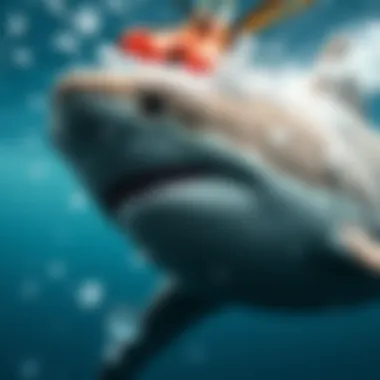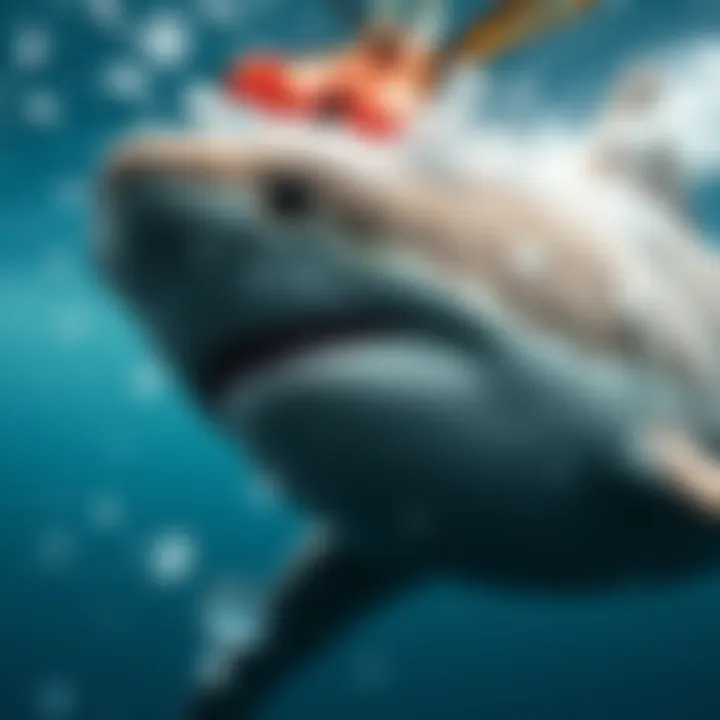Exploring the Habitat of the Great White Shark


Intro
The great white shark is an apex predator that commands both awe and respect in the marine world. Understanding its habitat is not just about pinpointing where these magnificent creatures reside but diving into the intricate web of factors that dictate their presence. The waters they inhabit are not just random; they are a result of complex environmental elements where prey availability, water temperature, and migratory patterns interplay delicately. In this exploration, we’ll break down their habitats, analyze the regions that are home to these sharks, and highlight how this critical understanding can inform preservation efforts.
The areas great whites call home vary widely, from the sunlit shallows of coastlines to the deep blue expanses of the ocean. Their distribution stretches across several oceans, showcasing how adaptable they can be in search for sustenance. It's intriguing to note that these sharks have particular preferences – favoring regions where prey like seals and fish flourish. Their incredible sense of geography is not just instinctual; it’s a learned behavior based on environmental cues that point them toward locations rich in food.
In everything from their breeding patterns to seasonal migrations, great white sharks provide an essential ecological role in maintaining the health of marine systems. By recognizing their habitats, we can better appreciate the broader implications for oceanic well-being and the conservation strategies necessary to safeguard these remarkable creatures.
"Understanding the habitat of the great white shark serves as a doorway into the broader marine ecosystem, highlighting connections that may not be immediately evident."
In what follows, we'll explore the intricate factors and conditions that define the realms of the great white shark, with an emphasis on why these details matter not only to the sharks themselves but also to the entire oceanic environment.
Understanding the Great White Shark
The Great White Shark, often regarded as the apex predator of the ocean, commands the respect and intrigue of marine enthusiasts and casual observers alike. Images of this fearsome creature evoke a sense of awe as well as apprehension. It is essential to unpack what makes the Great White Shark such an extraordinary species within the marine ecosystem. Understanding its physical attributes, behavioral patterns, and ecological roles isn't just for academic purposes—it helps surfboarders, marketers, and travel planners appreciate their significance in the aquatic world.
Knowledge of the Great White Shark's characteristics sheds light on how it has adapted to become a dominant predator. Moreover, observing its diet and behavior will enhance comprehension of how it interacts with its environment and other species. Understanding these dimensions contributes to our overall grasp of marine ecosystems, ultimately influencing conservation strategies and public perception.
Physical Characteristics
The Great White Shark is easily recognizable, with its robust build and distinguishing color pattern. These creatures can grow up to 20 feet in length, with a streamlined body designed for speed and agility. Their dorsal side is a greyish color, which serves as a camouflage when viewed from above, while their underbelly is white, providing concealment from prey swimming beneath.
One of the most remarkable features of the Great White is its keen senses. Possessing highly developed olfactory bulbs, they can detect blood in concentrations as low as one part per 10 billion. Their lateral line system, sensitive to vibrations and changes in water pressure, allows them to sense movement around them. These adaptations are crucial for hunting and navigating the ocean depths.
Given these physical traits, one might wonder how they affect interactions with surfers and divers. Understanding how these characteristics enable the shark's predatory nature can help inform safety measures in popular surf zones, making enthusiasts more aware and potentially enriching their ocean experiences.
Behavior and Diet
An understanding of the Great White Shark's behavior is essential to grasp its role in the marine food chain. These sharks are known for their hunting efficiency, often employing a unique strategy known as the "sneak attack." They utilize their speed and force to surprise prey, which primarily consists of marine mammals such as seals and sea lions. However, they also consume a variety of fish and can adapt their diets based on availability.
The dietary habits of these sharks reveal much about the health of their environments. For instance, a decline in seal populations due to overfishing or pollution can directly affect the Great White's population. This interdependence accentuates the importance of monitoring marine ecosystems. To put it simply, the well-being of Great White Sharks often acts as a barometer for ocean health. Surfboarders and divers must recognize the potential ripple effects their activities may have on the broader ecology, fostering a sense of responsibility.
Role in Marine Ecosystems
As apex predators, Great White Sharks play an integral role in maintaining balanced marine ecosystems. By preying on weaker or sick individuals, they help control seal and sea lion populations, ultimately ensuring the health of these species. This ecological balance is vital; without the Great White Shark and similar species, the marine food web could collapse.
On a larger scale, the presence of Great Whites can also influence prey behavior, ensuring that fish populations do not overgraze vegetation, leading to healthier ocean habitats. > "Sharks are crucial for the health of the oceans; they keep the balance in life below the waves."
For marketers and travel planners targeting marine tourism, this ecological knowledge can enhance promotional materials, emphasizing the importance of respecting the ocean's complex web of life. Additionally, education on this topic can engage surfboarders in conversations about ocean stewardship, fostering an environment where both humans and marine life thrive.
Through thorough awareness and appreciation of the Great White Shark, we can cultivate a greater understanding of its habitat and its significane in marine health.
Geographical Distribution


Understanding the geographical distribution of the great white shark is crucial, as it tells us where these incredible creatures choose to reside and why. Knowing their preferred habitats can help us grasp their ecological needs and contribute to their conservation. Factors like water temperature and prey availability play a significant role in deciding which waters become the sharks' home. For enthusiasts, researchers, and conservationists alike, this understanding is fundamental in recognizing how pressing environmental issues could alter these habitats.
Regions of Abundance
North Pacific
The North Pacific is a key area for great white sharks. They can be found frequently near coastal waters, which are rich in nutrients and prey. A striking feature of this region is the rich ecosystem provided by the continental shelf, especially around places like California and Hawaii. This makes the North Pacific a favored choice for these sharks. The inherent bustling marine life acts as a buffet for great whites, supporting their growth and reproduction. The downside, however, is that this high human activity area faces threats like overfishing and habitat degradation, which could impact shark populations negatively.
North Atlantic
Turning to the North Atlantic, we find a different kind of environment that's pivotal for great whites. The waters off the eastern coast of the United States and parts of Europe showcase a dynamic blend of currents, which creates an area rich in various fish species. This region acts as a feeding ground during summer months when temperatures rise, prompting prey species to gather. Nonetheless, the North Atlantic encounters its share of challenges, such as shipping lanes and commercial fishing, which can disrupt shark movements and increase the risk of injury.
Southern Ocean
As we drift farther south, the Southern Ocean presents an entirely unique setting for the great white shark. Here, the water is colder and the conditions harsher, which, surprisingly, supports a diverse range of life. Known for its rich krill and seal populations, the Southern Ocean is a wintering territory for many sharks. The remoteness of this habitat is a benefit, offering a reprieve from human impacts that are prevalent in more populated areas. However, climate change poses a looming threat to the delicate balance of this ecosystem, raising concerns about the future of these sharks in such an essential habitat.
Migration Patterns
Seasonal Movements
The seasonal movements of great white sharks illustrate their adaptability to environmental changes. As seasons shift, so does their migration based on temperature and prey availability. They typically migrate to warmer waters during certain times of the year, seeking out areas that can support their hunting and reproductive needs. This seasonal adaptation allows sharks to maximize their feeding efficiency and ensure the survival of future generations. Yet, understanding these patterns is crucial for protection measures, especially during migration periods, where they might cross paths with fishing activities.
Influences of Water Temperature
Water temperature significantly influences great white shark behaviors and habitats. They thrive in temperatures ranging from 12°C to 24°C (53°F to 75°F). This optimal range affects their feeding habits, breeding cycles, and migration patterns. The relationship between sharks and water temperature is a classic example of how marine animals sync their behaviors with environmental conditions. However, the ongoing changes in ocean temperatures, due to climate variations, present potential disruptions in their natural habitats, pushing them toward less favorable conditions.
Preferred Habitats
The concept of preferred habitats is critical to understanding the life and prosperity of the great white shark. These habitats offer vital resources such as food, breeding grounds, and optimal water temperatures, all of which are essential for the survival of this apex predator. The meticulous analysis of preferred habitats illuminates how environmental conditions and ecological interactions shape the great white shark’s presence in the ocean.
Coastal Areas
Importance of Shoreline Zones
Coastal areas hold significant importance for great white sharks due to their unique ecological characteristics. These zones serve as nurseries where juvenile sharks can find ample food while being protected from larger predators. The abundance of prey near shorelines—such as seals and fish—makes it a hunting ground that's hard to beat. Furthermore, the shallow waters warm quicker, allowing for a favorable environment not only for sharks but for various marine life that thrive in these conditions.
The key characteristic of these shoreline zones is their rich biodiversity and relatively stable environmental conditions. As a result, they become a beneficial choice for the sharks’ hunting strategies. However, with these advantages come some unique features: coastal areas also face pressure from human activities, such as fishing and coastal development, which could disrupt this essential habitat. Therefore, it becomes crucial to assess how much these human endeavors impact the habitats that young sharks depend upon.
Impact of Human Activities
The impact of human activities on the coastal areas where great whites thrive cannot be overstated. Coastal development, pollution, and overfishing are just a few examples of how human intervention jeopardizes the delicate balance of marine ecosystems. One of the most pressing issues is overfishing, which reduces the availability of prey, making it challenging for the sharks to find sufficient food.
The key characteristic of this impact is the alteration of the natural habitat. This can lead to a decrease in shark populations as they struggle to adapt to changing conditions or relocate to less familiar areas. The unique feature of this scenario is its dual-faced nature: while human activities can lead to habitat loss, conservation efforts also gain momentum in these areas. Therefore, it's crucial to strike a balance between enjoying coastal resources and preserving them for the future.


Open Ocean
Depth and Temperature Analysis
The open ocean presents a different landscape altogether, vital for the great white shark’s survival. This habitat is characterized by varying depths and temperature gradients, influencing shark behavior and distribution. Generally, great white sharks prefer waters between 60°F (15.5°C) and 75°F (24°C), where their prey, like schools of fish, are abundantly found.
The depth and temperature analysis of the open ocean showcases a fascinating characteristic: the thermal stratification that develops in different ocean zones. This phenomenon is not merely geographical; it helps dictate where sharks will migrate and hunt. The beneficial aspect of understanding these parameters allows scientists and conservationists to better predict shark movements for protection purposes. However, it’s necessary to mention that the advantage of deep waters is juxtaposed against the challenges of food scarcity at certain depths, making it a gamble for nourishment.
Interactions with Other Species
Interactions with other species in the open ocean contribute significantly to the ecological roles played by great white sharks. Their presence influences populations of seals, fish, and even other shark species. The complexity of these interactions reveals the interdependence within marine ecosystems.
The key characteristic here is the predator-prey relationship that embodies the circular nature of ocean life. Great white sharks, being apex predators, help maintain the balance by ensuring that weaker species do not dominate the food chain. Understanding these interactions is a beneficial aspect of acknowledging the shark’s position in marine ecosystems. Nevertheless, the unique feature of these dynamics is that they are sensitive to ecological changes; shifts in prey populations due to climate change or human impact can ripple through the entire ecosystem, affecting all interlinked species.
The habitats of the great white shark illustrate not just where these creatures thrive, but highlight the broader ecosystem's health and the ongoing need for conservation.
By analyzing the preferred habitats of the great white shark, we can better appreciate their role in marine ecosystems, the implications of environmental changes, and the necessity for thoughtful conservation efforts. Resources such as Britannica, and governmental sites like NOAA offer extensive insights into marine conservation pivotal in protecting these remarkable creatures.
Environmental Factors Affecting Habitat
Understanding the environmental factors affecting the habitat of the great white shark is crucial for grasping how these formidable predators thrive in their oceanic realms. Various elements contribute to the sustainability of their environments—each factor plays a unique role in shaping lifestyle, behavior, and distribution. Here, we focus on three pivotal components: water temperature, prey availability, and salinity along with ocean currents.
Water Temperature
Water temperature serves as a guiding compass for the great white shark's habitat choices. These sharks prefer temperatures ranging from about 12°C to 24°C, although they can occasionally be found in warmer waters. This range influences their hunting activities, reproductive cycles, and migration paths. As ectothermic animals, great whites rely on the surrounding temperature to regulate their body heat, which impacts their metabolism.
Assuming they are too far north or south of their preferred zones, they may exhibit unusual behavior, such as prolonged resting or decreased feeding activity, which in turn can affect their health and population dynamics. For example, during warmer months, when surface temperatures rise, great whites often move closer to the shore in search of bountiful prey, increasing the likelihood of encounters with humans—hence the heightened interest from surfboarding enthusiasts.
"Temperature changes in ocean waters can lead to shifts in great white shark populations, ultimately affecting not just the sharks themselves but the entire marine ecosystem."
Prey Availability
Prey availability directly informs the feeding habits and migration patterns of great white sharks. These apex predators primarily feast on seals, sea lions, and smaller fish, which are abundant in certain coastal and offshore areas. The presence of prey can vary significantly based on season, ocean currents, and local ecosystems. For instance, during the Heinous seal pupping season, specific regions become hotspots for great whites as they capitalize on an easy meal.
Moreover, shifts in local fish populations due to overfishing or climate impact can ripple through the food web, affecting where great whites can effectively hunt. An understanding of these prey dynamics is not only critical for the sharks' survival but is also imperative for conservation efforts aiming to protect their natural habitats.
Salinity and Ocean Currents
Salinity levels and ocean currents are two intertwined factors that help dictate the habitats where great white sharks flourish. Ocean currents, driven by wind, water temperature, and the earth's rotation, can dictate the distribution of nutrients and, consequently, marine life. In return, this directly influences where sharks can be found.
Different species of prey thrive under varying salinity conditions; hence, great whites may follow these prey migrations. Higher salinity areas generally indicate less fresh water influx, creating a robust ecosystem conducive for certain prey species. Conversely, understanding the areas where salinity and currents fluctuate can provide insight into the potential feeding hotspots for great whites.
In summary, the habitat of the great white shark is a complex interplay of various environmental factors. By considering how water temperature, prey availability, and salinity interact with ocean currents, we can get a clearer picture of these magnificent creatures in the wild and the challenges they face in a rapidly changing world. Such knowledge is vital for conservationists and policymakers aiming to protect their environments while ensuring the safety of oceanic activities, particularly those involving surfboarders.


For further reading, consider exploring resources such as Wikipedia on Shark Biology, Britannica's entry on Marine Ecology, and oceanographic studies available from various governmental and educational institutions.
Conservation Status
Understanding the conservation status of the great white shark is critical not just for the species but also for the health of our oceans. As an apex predator, its presence indicates a balanced ecosystem. When evaluating their conservation status, we confront several key factors that highlight the challenges these remarkable creatures face, as well as the steps being taken to ensure their survival.
Threats to Habitat
Overfishing
Overfishing poses a significant threat to great white sharks and their habitats. This not only targets these sharks directly but also disrupts their food web. With heavy fishing practices, many smaller fish that these sharks rely on for sustenance vanish, making it hard for them to find enough to eat. A concerning aspect is that the method of fishing impacts not only the target species but also numbers of bycatch, including juvenile sharks. Without a diverse and plentiful prey base, the very survival of the species is at risk.
- Key Characteristic: The fishing practices often lack regulation, leading to the unintentional capture and killing of great whites.
- Advantages/Disadvantages: While there's rigorous debate about the economic benefits of fishing, declining shark populations can have long-lasting negative effects on marine life, which can, in turn, affect the fishing industry itself.
Climate Change
Climate change affects great white sharks chiefly through changing ocean conditions. Rising water temperatures can alter migration patterns and breeding habits. Sharks thrive in certain thermal ranges, and any significant shifts can lead to the depletion of local populations in traditional habitats. For instance, increased temperatures may push sharks towards deeper, cooler waters, which can impact their hunting efficiency and their interactions with other marine species.
- Key Characteristic: Climate change has a ripple effect — from the coral reefs that serve as breeding grounds to the diverse fish populations that form their diet, all elements are interlinked.
- Advantages/Disadvantages: While promoting global awareness of climate change is crucial, tangible conservation measures must be implemented to ensure the survival of great whites as shifting habitats can lead to severe population declines.
Conservation Efforts
Several initiatives aimed are at reversing the negative trends affecting great white sharks. Organizations are working tirelessly to combine research with policy-making to create safe havens for these creatures. From marine protected areas designed to conserve their habitats to outreach programs that educate the public on the importance of shark conservation, every step counts.
Additionally, global bans on shark finning illustrate a broader shift in perspective about these animals. By prioritizing the health of ocean ecosystems, we benefit not just the great whites but many other species that share their environment.
As stakeholders, including recreational surfers, divers, and environmentalists, come together, the conservation dialogue is more urgent than ever. Great white sharks should not be seen merely as terrifying predators; they are essential to the ocean's balance, serving as a bellwether for the overall health of marine environments.
"By understanding the plight of the great white shark, we understand the precarious balance of marine life. It's not just their survival that’s at stake, but the whole ocean ecosystem."
Implications for Surfboarding Enthusiasts
The relationship between surfboarding and the habitat of the great white shark is complex yet fascinating. For surfboarders, understanding the behavior and movement of this apex predator can enhance not just their experience but also their safety. With the increase of surfers hitting the waves, it’s imperative to shed light on key considerations that can help tackle fears and facilitate safer surfing practices.
Safety Considerations
Surfing in waters that are known to be frequented by great white sharks raises valid safety concerns. Here are several elements worth knowing:
- Local Shark Activity: Many coastal areas are known hotspots for great whites. Places like California's Monterey Bay or the waters around South Africa often see these sharks. Being aware of current shark activity reports can help surfers choose the best times and locations for their surf sessions, minimizing risk.
- Time of Day: Great whites tend to hunt during dawn and dusk. Surfers should consider avoiding these peak feeding times when the water is murkier and visibility is low, as this can increase the chances of mistaken identity.
- Fish Schools and Seals: Surfing near schools of fish or areas where seals congregate could attract great whites. It’s best to stay at a distance from such hotspots, reducing the likelihood of a shark encounter.
- Surfboard Color: Studies suggest that certain colors may attract sharks more than others. Brightly colored boards that resemble prey could lead to unwanted attention. Opting for more neutral colors can help in this context.
Education is key. Surfboarders should engage with local marine life education programs that focus on the behavior of great whites. This knowledge can lead to smarter choices in the water.
Understanding Marine Ecology
To appreciate the habitat of the great white shark fully, surfers should delve into marine ecology. Understanding how these creatures interact within the ocean can demystify their presence.
- Food Web Dynamics: Great whites play an essential role in their ecosystems, primarily as apex predators. By controlling the population of marine mammals, they help balance marine ecosystems, which directly influences the health of the waters where surfers enjoy their sport.
- Environmental Changes: Shifts in water temperature affect the distribution of great white sharks, as they thrive in cooler waters. This has implications for surfboarders, as migratory patterns can take sharks to new areas, altering where they may surf in the future.
- Conservation Efforts: By participating in marine conservation, surfers can contribute to the preservation of ocean habitats. Engaging in beach clean-ups or supporting organizations that promote shark safety and ecological awareness can lead to a sustainable and enjoyable surfing experience for future generations.
"The sea is a source of life, and its intricacies must be respected for us to cohabit safely with its majesty."
By weaving these threads of knowledge into the fabric of surfing culture, enthusiasts can create a safer, more understanding connection with the oceans they ride. Such insights not only benefit individuals but enrich the surfing community as a whole.















